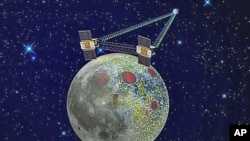The U.S. space agency, NASA, has celebrated the new year with twin spacecraft circling the Moon on a mission to study its gravitational field and internal structure.
NASA launched the two unmanned Gravity Recovery and Interior Laboratory, or GRAIL, probes in September. The first probe, GRAIL A, was placed into lunar orbit on Saturday, and the second, GRAIL B, followed on Sunday.
The orbiting GRAIL spacecraft are scheduled to spend about 90 days gathering data to create the first complete high-resolution map of the Moon’s curiously uneven gravitational field. Scientists say they will use the new gravity data to find out what goes on beneath the lunar surface, “from crust to core.”
Mission principal researcher, Maria Zuber of the Massachusetts Institute of Technology, says the GRAIL project will, in her words, “rewrite the textbooks on the evolution of the Moon.”
NASA says it expects insights from the GRAIL mission will lead to a better understanding of how the Earth and the three other rocky planets (Mercury, Venus and Mars) in the inner solar system developed into the diverse worlds seen today.
NASA anticipates that GRAIL’s comprehensive map of the Moon’s gravitational field also will provide an important navigational tool for future lunar spacecraft. The space agency says it plans to plunge both GRAIL spacecraft into the lunar surface several weeks after the orbital mapping mission is complete.
The Moon orbits the Earth from an average distance of around 385,000 kilometers. It has a diameter of nearly 3,500 kilometers. By contrast, the Earth’s is 12,756 kilometers-wide. Because the Moon is smaller and has less mass, the force of gravity on the lunar surface is only 17 percent of that on Earth. That means the same object that weighs 100 kilograms on Earth will weigh only 17 kilograms on the Moon.
Astronomers believe the Moon formed 30 to 50 million years after the rest of our solar system first coalesced from leftover stellar dust and gas 4.6 billion years ago. The dominant theory is that the Moon is made of debris that circled the still-molten Earth in the wake of a cataclysmic collision with a smaller Mars-sized protoplanet.









